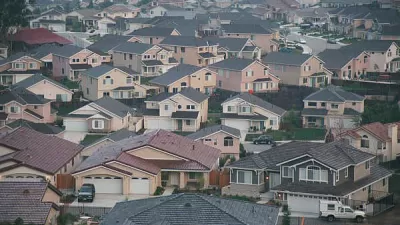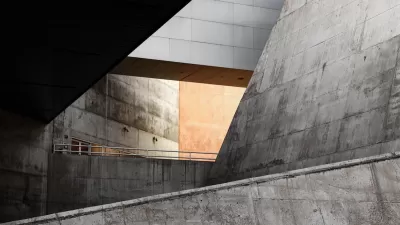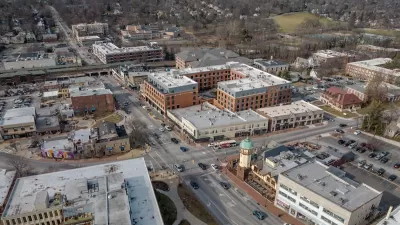A review of Retrofitting Suburbia: Urban Design Solutions for Redesigning Suburbs by Ellen Dunham-Jones and June Williamson, from Residential Architect Online.
"Dunham-Jones and Williamson argue that retrofitting defunct or failing malls, parking lots, commercial strips, office parks, and cul-de-sac subdivisions from single-use, auto-dependent, low-density suburbs into vital and diverse higher-density, mixed-use urban centers is the best and most sustainable solution for accommodating evolving demographics, technological advances, and economic conditions. The projects highlighted were chosen for their real-world application of new trends in planning, development, economics, policy, and design.
Why are suburban retrofits such a good solution? As Dunham-Jones said in a discussion of the book, "There are benefits at several different scales."
At some point, the book contends, we'll have to accept that transportation costs aren't getting any lower. Household budgets would benefit from the reduced transportation costs that urbanized suburban neighborhoods provide through improved walkability and access to mass transit, as well as their ability to reduce the number and length of car trips needed to reach the more-plentiful services and retail allowed by redevelopment. "With good mixed-use development, you can capture between 25 and 45 percent of the trips internally," Dunham-Jones says."
FULL STORY: redesigning suburbia for a changing world

Manufactured Crisis: Losing the Nation’s Largest Source of Unsubsidized Affordable Housing
Manufactured housing communities have long been an affordable housing option for millions of people living in the U.S., but that affordability is disappearing rapidly. How did we get here?

Americans May Be Stuck — But Why?
Americans are moving a lot less than they once did, and that is a problem. While Yoni Applebaum, in his highly-publicized article Stuck, gets the reasons badly wrong, it's still important to ask: why are we moving so much less than before?

Research Shows More Roads = More Driving
A national study shows, once again, that increasing road supply induces additional vehicle travel, particularly over the long run.

Judge Halts Enforcement of Anti-Homeless Laws in Grants Pass
The Oregon city will be barred from enforcing two ordinances that prosecute unhoused residents until it increases capacity and accessibility at designated camping sites.

Advancing Sustainability in Los Angeles County Schools
The Los Angeles County Office of Education’s Green Schools Symposium brings together educators, students, and experts to advance sustainability in schools through innovative design, climate resilience strategies, and collaborative learning.

Using Old Oil and Gas Wells for Green Energy Storage
Penn State researchers have found that repurposing abandoned oil and gas wells for geothermal-assisted compressed-air energy storage can boost efficiency, reduce environmental risks, and support clean energy and job transitions.
Urban Design for Planners 1: Software Tools
This six-course series explores essential urban design concepts using open source software and equips planners with the tools they need to participate fully in the urban design process.
Planning for Universal Design
Learn the tools for implementing Universal Design in planning regulations.
City of Moreno Valley
Institute for Housing and Urban Development Studies (IHS)
City of Grandview
Harvard GSD Executive Education
NYU Wagner Graduate School of Public Service
City of Cambridge, Maryland
Newport County Development Council: Connect Greater Newport





























